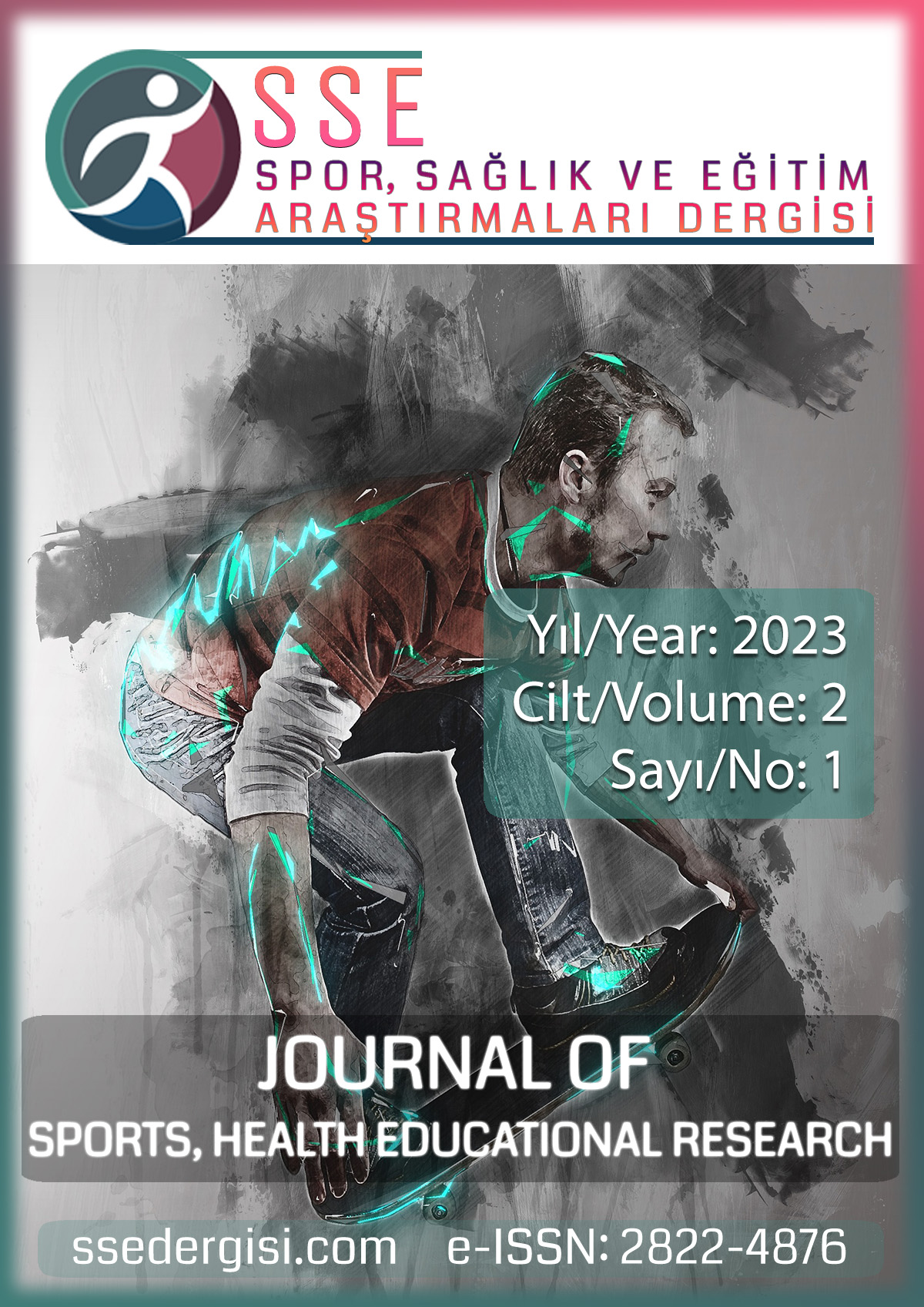Effect Of Hıgh Intensıty Interval Traınıng On Aerobıc Capacıty In Boxers
Keywords:
Boxing, Aerobic, High-Intensity Interval TrainingAbstract
Aim: The aim of this study was to investigate the effect of high-intensity interval training on aerobic capacity in boxers. Materials and Methods: A total of 18 male students voluntarily participated in the study, who were enrolled in the Hasan Doğan School of Physical Education and Sports at Karabük University and engaged in boxing sports. Participants were randomly divided into two groups: an experimental group (average age 23.22±1.71 years, average height 1.75±0.05 m, average body weight 72.32±8.98 kg) and a control group (average age 22.44±1.74 years, average height 1.74±0.07 m, average body weight 72.07±13.29 kg), consisting of 9 individuals each. The experimental group, in addition to their routine training, participated in a high-intensity interval training program for 6 weeks, three days a week. The control group continued their regular training. As the data showed a normal distribution, the paired t-test was used to compare the pre-test and post-test values. A confidence interval of p<0.05 was used for statistical procedures. Results: Upon examination, it was observed that the experimental group statistically significantly decreased in weight and VYY, and statistically significantly increased in VKK and VO2Max levels. In the control group, no statistically significant changes were observed in weight, VKK, VYY, and VO2Max levels (p<0.05). Conclusion: In the light of this information, athletes can increase their performance by using the high-intensity interval training method before the competition and during the camps.
References
Alan, RB., Josephıne, D., Aaron, S., Bert, B., ve Craıg, A. (2014). Wıllıams. The Influence of 2 Weeks of Low-Volume High Intensity Interval Training on Health Outcomes In Adolescent Boys. Journal Of Sport Sciences. 32(8), 757-765.
Alonso-Fernández, D., Fernández-Rodríguez, R., Taboada-Iglesias, Y., ve Gutiérrez-Sánchez, Á. (2019). Impact of a HIIT protocol on body composition and VO2max in adolescents. Science Sports, 34(5), 341-347.
Alonso-Fernández, D., Lima-Correa, F., Gutierrez-Sánchez, Á., ve De Vicuña, O. A. G. (2017). Effects of a high-intensity interval training protocol based on functional exercises on performance and body composition in handball female players. Journal of Human Sport and Exercise, 12(4), 1186-1198.
Bompa, T.O., Haff, G.G. (2015). Dönemleme: Antrenman kuramı ve yöntemi. Çev. Tanju Bağırgan), Beşinci Basım, Ankara: Spor Yayınevi ve Kitabevi.
Buchheit, M. & Laursen, P. B. (2013). High-intensity interval training solutions to the programming puzzle. Sports Medicine, 43(10), 927-954.
Fox, E.L., Bowers, R.W., Foss, M.L. (1999). Physiological foundations of physical education and sports. Beden Eğitimi ve Sporun Fizyolojik Temelleri. Ankara: Bağırgan Yayınevi.
Gharah, D.N., Kordi, M.R., & Gaeini, A.A. (2014). The effect of 4-week high intensity interval aerobic training VO2max, TMAX, VO2max of Iranian club soccer players. Biol. Exerc. Sci, 17, 47-57.
Gibala MJ, McGee SL. Metabolicadaptationsto short-termhigh-intensity interval training: a little pain for a lot of gain. Exerc Sport Science. Rev. 2008; 36:58Y63.
Gillen, J. B., Percival, M. E., Skelly, L. E., Martin, B. J., Tan, R. B., Tarnopolsky, M. A., & Gibala, M. J. (2014). Three minutes of all-out intermittent exercise per week increases skeletal muscle oxidative capacity and improves cardiometabolic health. PloS one, 9(11).
Hazell, T. J., Hamilton, C. D., Olver, T. D., ve Lemon, P. W. (2014). Running sprint interval training induces fat loss in women. Applied Physiology, Nutrition, and Metabolism, 39(8), 944-950.
Helgerud, J., Engen, L.C., Wisløff, U., & Hoff, J. (2001). Aerobic endurance training improves soccer performance. Medicine & Science in Sports & Exercise, 33(11), 1925-1931.
Karayiğit, R., Cengizhan, S. A. R. I., Aysu, Ö. N. A. L., Durmuş, T., & Büyükçelebi, H. (2020). Yüksek Şiddetli İnterval Antrenmanların (Hııt) Aerobik Dayanıklılık Ve Vücut Yağ Yakımı Üzerine Etkileri. Spormetre Beden Eğitimi Ve Spor Bilimleri Dergisi, 18(4), 1-13.
Karp, J. R. (2000). Interval training for the fitness professional. Strength & Conditioning Journal, 22(4), 64.
Kıyar, K.R. (2011). 14-17 Yaş Grubu Tenisçilere, Genel Hazırlık Döneminde Yaptırılan 8 Haftalık Dayanıklılık Antrenmanlarının Maks VO2 Değerleri Üzerine Etkisi. Yüksek Lisans Tezi, Sakarya Üniversitesi, Eğitim Bilimleri Enstitüsü, Sakarya.
Sevim Y. (2010). Antrenman Bilgisi. 8. Baskı, Ankara: Fil Yayınevi.
Sperlich, B., De Marées, M., Koehler, K., Linville, J., Holmberg, H.C., Mester, J.(2011). Effects of 5 Weeks of High-İntensity İnterval Training Vs. Volume Training in 14-Year-Old Soccer Players. The Journal of Strength Conditioning Research, 25, 1271-8.
Yavuz, A., & Dağdelen, S. (2021). Elit güreşçilerde HIIT antrenmanın vücut kompozisyonu üzerine akut etkisinin bioelektrik impedans analizi ile incelenmesi. Spor Eğitim Dergisi, 5(3), 196-204.
Downloads
Published
How to Cite
Issue
Section
License
Copyright (c) 2023 Spor, Sağlık ve Eğitim Araştırmaları Dergisi

This work is licensed under a Creative Commons Attribution-NonCommercial 4.0 International License.


